ECU VOLKSWAGEN POLO 2015 Owner´s Manual
[x] Cancel search | Manufacturer: VOLKSWAGEN, Model Year: 2015, Model line: POLO, Model: VOLKSWAGEN POLO 2015Pages: 100, PDF Size: 4.14 MB
Page 36 of 100
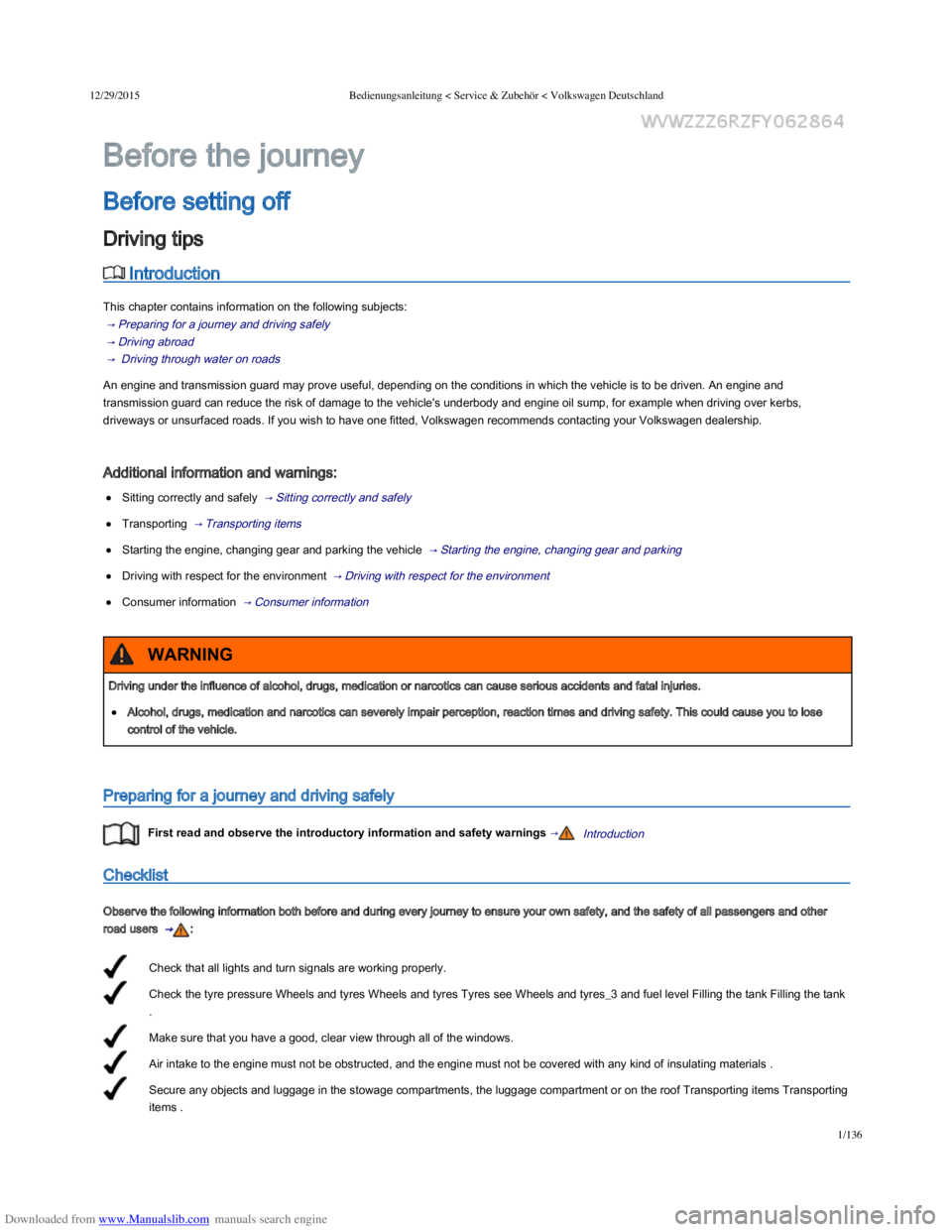
Downloaded from www.Manualslib.com manuals search engine 12/29/2015Bedienungsanleitung < Service & Zubehör < Volkswagen Deutschland
1/136
Check that all lights and turn signals are working properly.
Check the tyre pressure Wheels and tyres Wheels and tyres Tyres see Wheels and tyres_3 and fuel level Filling the tank Filling the tank
.
Make sure that you have a good, clear view through all of the windows.
Air intake to the engine must not be obstructed, and the engine must not be covered with any kind of insulating materials .
Secure any objects and luggage in the stowage compartments, the luggage compartment or on the roof Transporting items Transporting
items .
Introduction
This chapter contains information on the following subjects:
→ Preparing for a journey and driving safely
→ Driving abroad
→ Driving through water on roads
An engine and transmission guard may prove useful, depending on the conditions in which the vehicle is to be driven. An engine and
transmission guard can reduce the risk of damage to the vehicle's underbody and engine oil sump, for example when driving over kerbs,
driveways or unsurfaced roads. If you wish to have one fitted, Volkswagen recommends contacting your Volkswagen dealership.
Additional information and warnings:
Sitting correctly and safely → Sitting correctly and safely
Transporting → Transporting items
Starting the engine, changing gear and parking the vehicle → Starting the engine, changing gear and parking
Driving with respect for the environment → Driving with respect for the environment
Consumer information → Consumer information
Preparing for a journey and driving safely
First read and observe the introductory information and safety warnings →Introduction
Checklist
Observe the following information both before and during every journey to ensure your own safety, and the safety of all passengers and other
road users → :
Before the journey
Before setting off
Driving tips
Driving under the influence of alcohol, drugs, medication or narcotics can cause serious accidents and fatal injuries.
Alcohol, drugs, medication and narcotics can severely impair perception, reaction times and driving safety. This could cause you to lose
control of the vehicle.
WARNING
Page 37 of 100
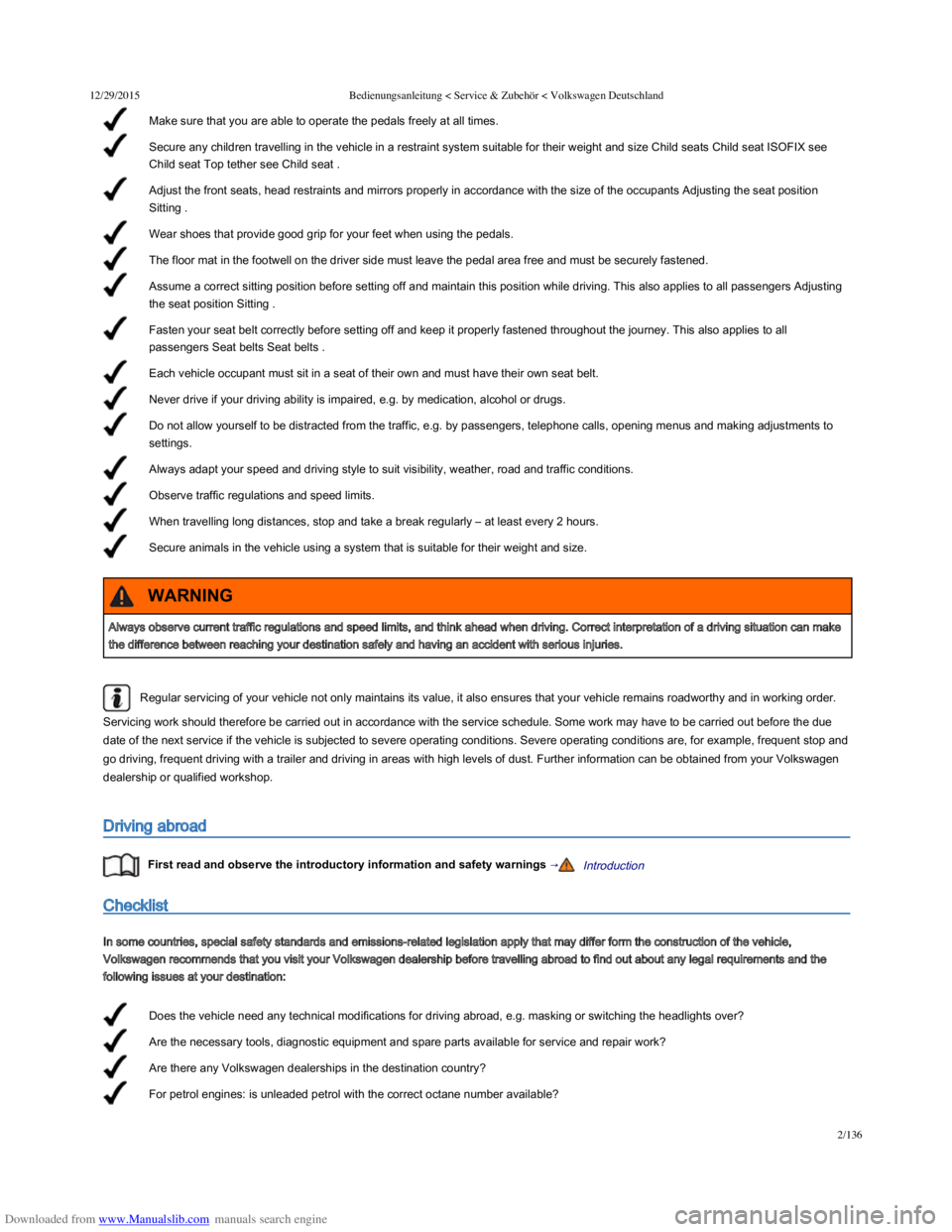
Downloaded from www.Manualslib.com manuals search engine 12/29/2015Bedienungsanleitung < Service & Zubehör < Volkswagen Deutschland
2/136
Make sure that you are able to operate the pedals freely at all times.
Secure any children travelling in the vehicle in a restraint system suitable for their weight and size Child seats Child seat ISOFIX see
Child seat Top tether see Child seat .
Adjust the front seats, head restraints and mirrors properly in accordance with the size of the occupants Adjusting the seat position
Sitting .
Wear shoes that provide good grip for your feet when using the pedals.
The floor mat in the footwell on the driver side must leave the pedal area free and must be securely fastened.
Assume a correct sitting position before setting off and maintain this position while driving. This also applies to all passengers Adjusting
the seat position Sitting .
Fasten your seat belt correctly before setting off and keep it properly fastened throughout the journey. This also applies to all
passengers Seat belts Seat belts .
Each vehicle occupant must sit in a seat of their own and must have their own seat belt.
Never drive if your driving ability is impaired, e.g. by medication, alcohol or drugs.
Do not allow yourself to be distracted from the traffic, e.g. by passengers, telephone calls, opening menus and making adjustments to
settings.
Always adapt your speed and driving style to suit visibility, weather, road and traffic conditions.
Observe traffic regulations and speed limits.
When travelling long distances, stop and take a break regularly – at least every 2 hours.
Secure animals in the vehicle using a system that is suitable for their weight and size.
Does the vehicle need any technical modifications for driving abroad, e.g. masking or switching the headlights over?
Are the necessary tools, diagnostic equipment and spare parts available for service and repair work?
Are there any Volkswagen dealerships in the destination country?
For petrol engines: is unleaded petrol with the correct octane number available?
Regular servicing of your vehicle not only maintains its value, it also ensures that your vehicle remains roadworthy and in working order.
Servicing work should therefore be carried out in accordance with the service schedule. Some work may have to be carried out before the due
date of the next service if the vehicle is subjected to severe operating conditions. Severe operating conditions are, for example, frequent stop and
go driving, frequent driving with a trailer and driving in areas with high levels of dust. Further information can be obtained from your Volkswagen
dealership or qualified workshop.
Driving abroad
First read and observe the introductory information and safety warnings →Introduction
Checklist
In some countries, special safety standards and emissions-related legislation apply that may differ form the construction of the vehicle,
Volkswagen recommends that you visit your Volkswagen dealership before travelling abroad to find out about any legal requirements and the
following issues at your destination:
Always observe current traffic regulations and speed limits, and think ahead when driving. Correct interpretation of a driving situation can make
the difference between reaching your destination safely and having an accident with serious injuries.
WARNING
Page 53 of 100
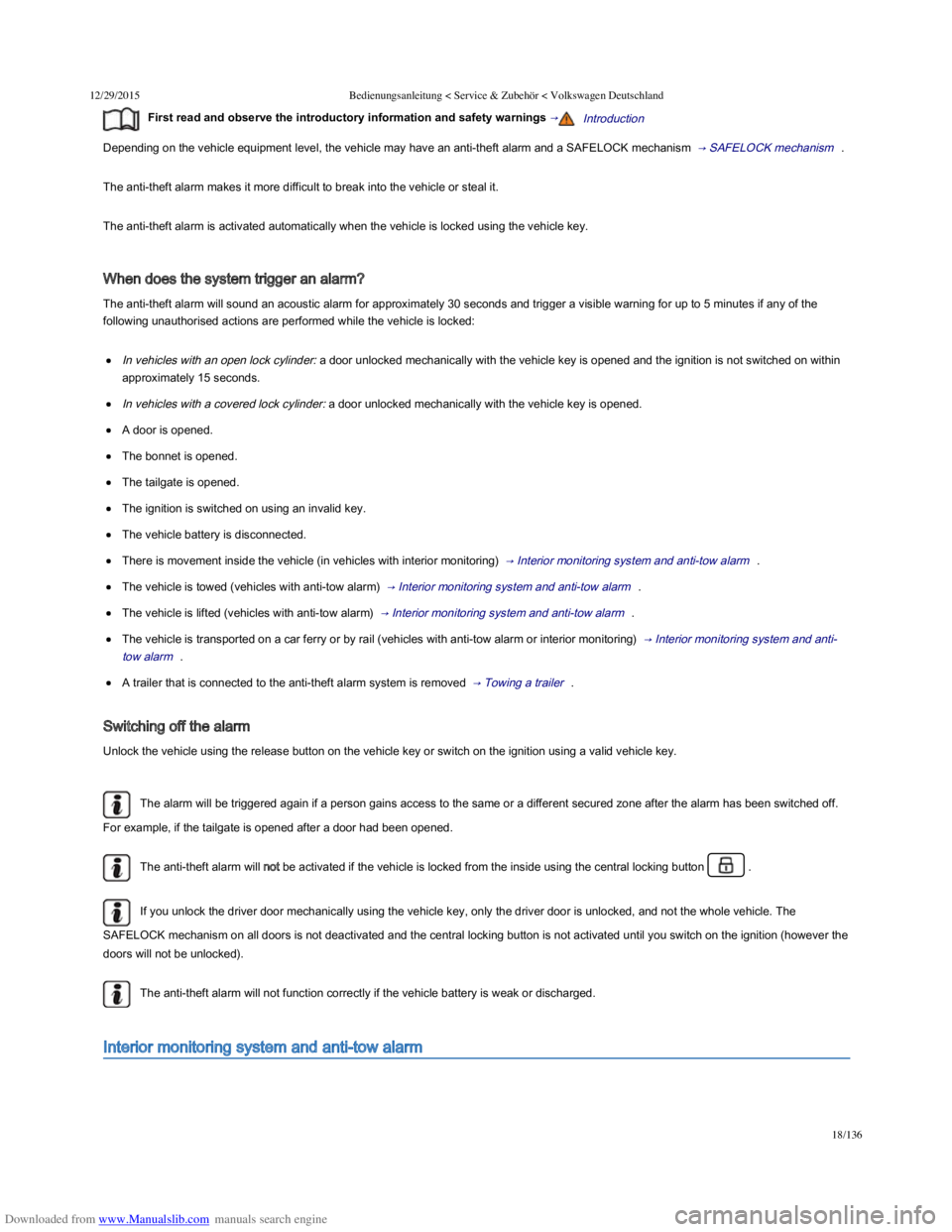
Downloaded from www.Manualslib.com manuals search engine 12/29/2015Bedienungsanleitung < Service & Zubehör < Volkswagen Deutschland
18/136
First read and observe the introductory information and safety warnings →Introduction
Depending on the vehicle equipment level, the vehicle may have an anti-theft alarm and a SAFELOCK mechanism → SAFELOCK mechanism .
The anti-theft alarm makes it more difficult to break into the vehicle or steal it.
The anti-theft alarm is activated automatically when the vehicle is locked using the vehicle key.
When does the system trigger an alarm?
The anti-theft alarm will sound an acoustic alarm for approximately 30 seconds and trigger a visible warning for up to 5 minutes if any of the
following unauthorised actions are performed while the vehicle is locked:
In vehicles with an open lock cylinder: a door unlocked mechanically with the vehicle key is opened and the ignition is not switched on within
approximately 15 seconds.
In vehicles with a covered lock cylinder: a door unlocked mechanically with the vehicle key is opened.
A door is opened.
The bonnet is opened.
The tailgate is opened.
The ignition is switched on using an invalid key.
The vehicle battery is disconnected.
There is movement inside the vehicle (in vehicles with interior monitoring) → Interior monitoring system and anti-tow alarm .
The vehicle is towed (vehicles with anti-tow alarm) → Interior monitoring system and anti-tow alarm .
The vehicle is lifted (vehicles with anti-tow alarm) → Interior monitoring system and anti-tow alarm .
The vehicle is transported on a car ferry or by rail (vehicles with anti-tow alarm or interior monitoring) → Interior monitoring system and anti-
tow alarm .
A trailer that is connected to the anti-theft alarm system is removed → Towing a trailer .
Switching off the alarm
Unlock the vehicle using the release button on the vehicle key or switch on the ignition using a valid vehicle key.
The alarm will be triggered again if a person gains access to the same or a different secured zone after the alarm has been switched off.
For example, if the tailgate is opened after a door had been opened.
The anti-theft alarm will not be activated if the vehicle is locked from the inside using the central locking button .
If you unlock the driver door mechanically using the vehicle key, only the driver door is unlocked, and not the whole vehicle. The
SAFELOCK mechanism on all doors is not deactivated and the central locking button is not activated until you switch on the ignition (however the
doors will not be unlocked).
The anti-theft alarm will not function correctly if the vehicle battery is weak or discharged.
Interior monitoring system and anti-tow alarm
Page 59 of 100
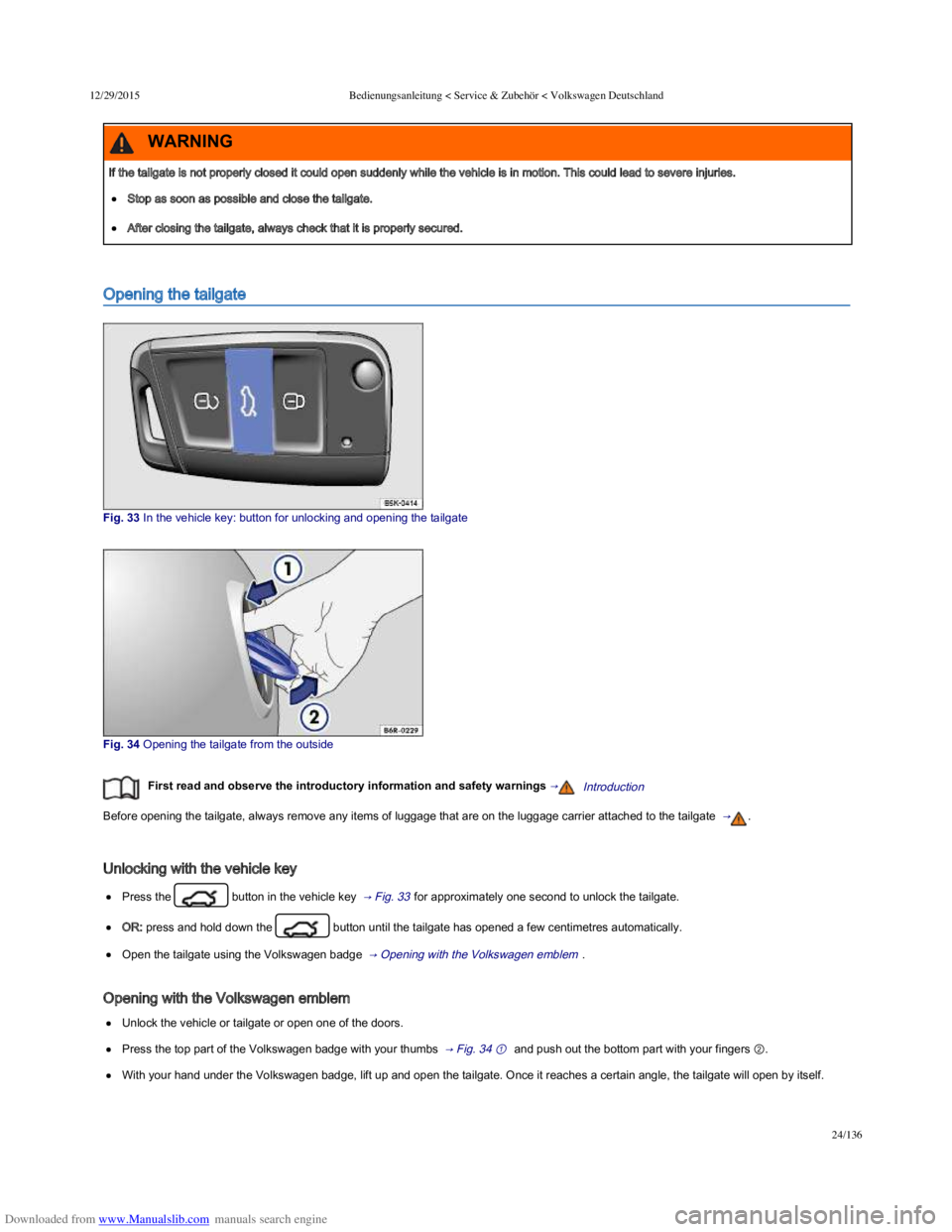
Downloaded from www.Manualslib.com manuals search engine 12/29/2015Bedienungsanleitung < Service & Zubehör < Volkswagen Deutschland
24/136
Opening the tailgate
Fig. 33 In the vehicle key: button for unlocking and opening the tailgate
Fig. 34 Opening the tailgate from the outside
First read and observe the introductory information and safety warnings →Introduction
Before opening the tailgate, always remove any items of luggage that are on the luggage carrier attached to the tailgate → .
Unlocking with the vehicle key
Press the button in the vehicle key → Fig. 33 for approximately one second to unlock the tailgate.
OR: press and hold down the button until the tailgate has opened a few centimetres automatically.
Open the tailgate using the Volkswagen badge → Opening with the Volkswagen emblem .
Opening with the Volkswagen emblem
Unlock the vehicle or tailgate or open one of the doors.
Press the top part of the Volkswagen badge with your thumbs → Fig. 34 ① and push out the bottom part with your fingers ②.
With your hand under the Volkswagen badge, lift up and open the tailgate. Once it reaches a certain angle, the tailgate will open by itself.
If the tailgate is not properly closed it could open suddenly while the vehicle is in motion. This could lead to severe injuries.
Stop as soon as possible and close the tailgate.
After closing the tailgate, always check that it is properly secured.
WARNING
Page 60 of 100
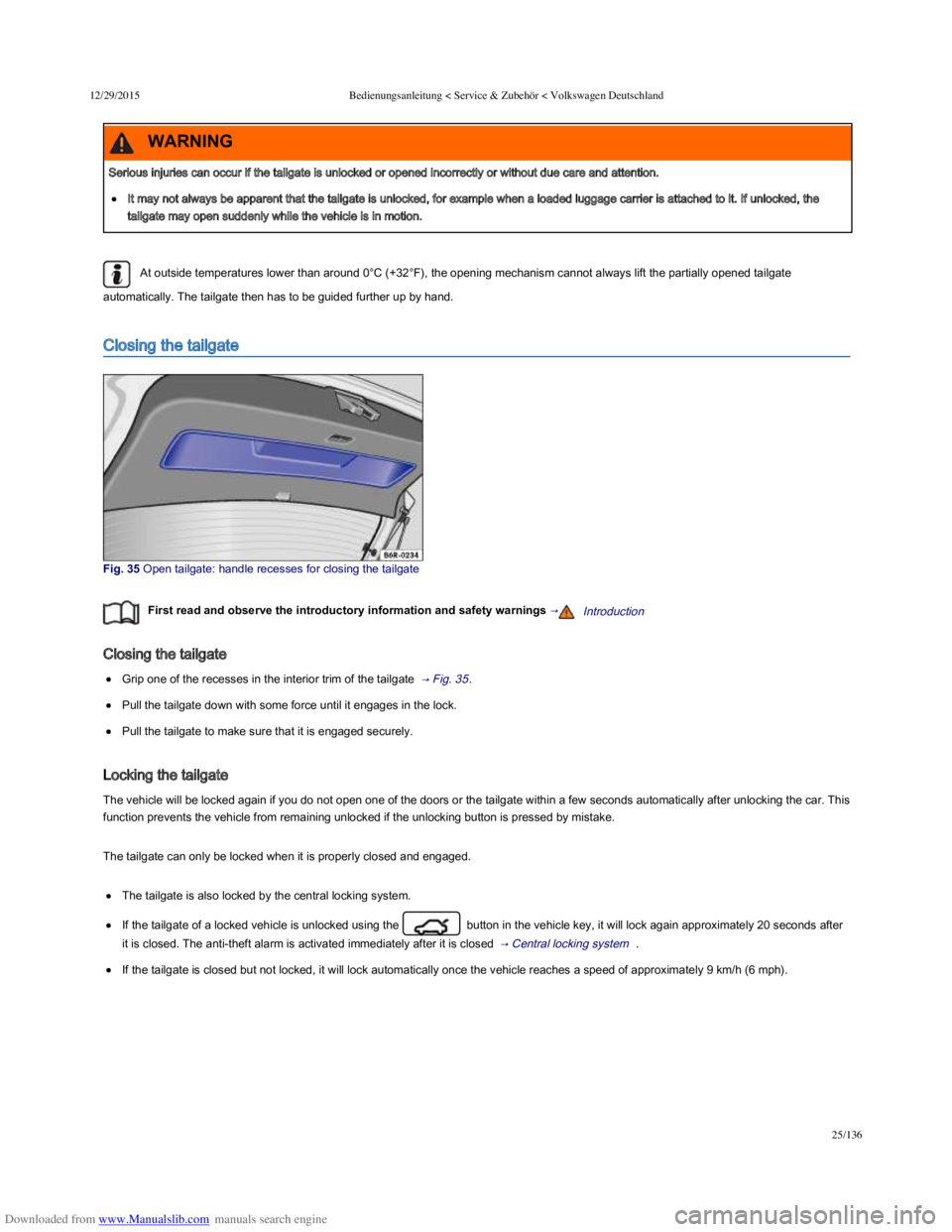
Downloaded from www.Manualslib.com manuals search engine 12/29/2015Bedienungsanleitung < Service & Zubehör < Volkswagen Deutschland
25/136
At outside temperatures lower than around 0°C (+32°F), the opening mechanism cannot always lift the partially opened tailgate
automatically. The tailgate then has to be guided further up by hand.
Closing the tailgate
Fig. 35 Open tailgate: handle recesses for closing the tailgate
First read and observe the introductory information and safety warnings →Introduction
Closing the tailgate
Grip one of the recesses in the interior trim of the tailgate → Fig. 35 .
Pull the tailgate down with some force until it engages in the lock.
Pull the tailgate to make sure that it is engaged securely.
Locking the tailgate
The vehicle will be locked again if you do not open one of the doors or the tailgate within a few seconds automatically after unlocking the car. This
function prevents the vehicle from remaining unlocked if the unlocking button is pressed by mistake.
The tailgate can only be locked when it is properly closed and engaged.
The tailgate is also locked by the central locking system.
If the tailgate of a locked vehicle is unlocked using the button in the vehicle key, it will lock again approximately 20 seconds after
it is closed. The anti-theft alarm is activated immediately after it is closed → Central locking system .
If the tailgate is closed but not locked, it will lock automatically once the vehicle reaches a speed of approximately 9 km/h (6 mph).
Serious injuries can occur if the tailgate is unlocked or opened incorrectly or without due care and attention.
It may not always be apparent that the tailgate is unlocked, for example when a loaded luggage carrier is attached to it. If unlocked, the
tailgate may open suddenly while the vehicle is in motion.
WARNING
Page 68 of 100
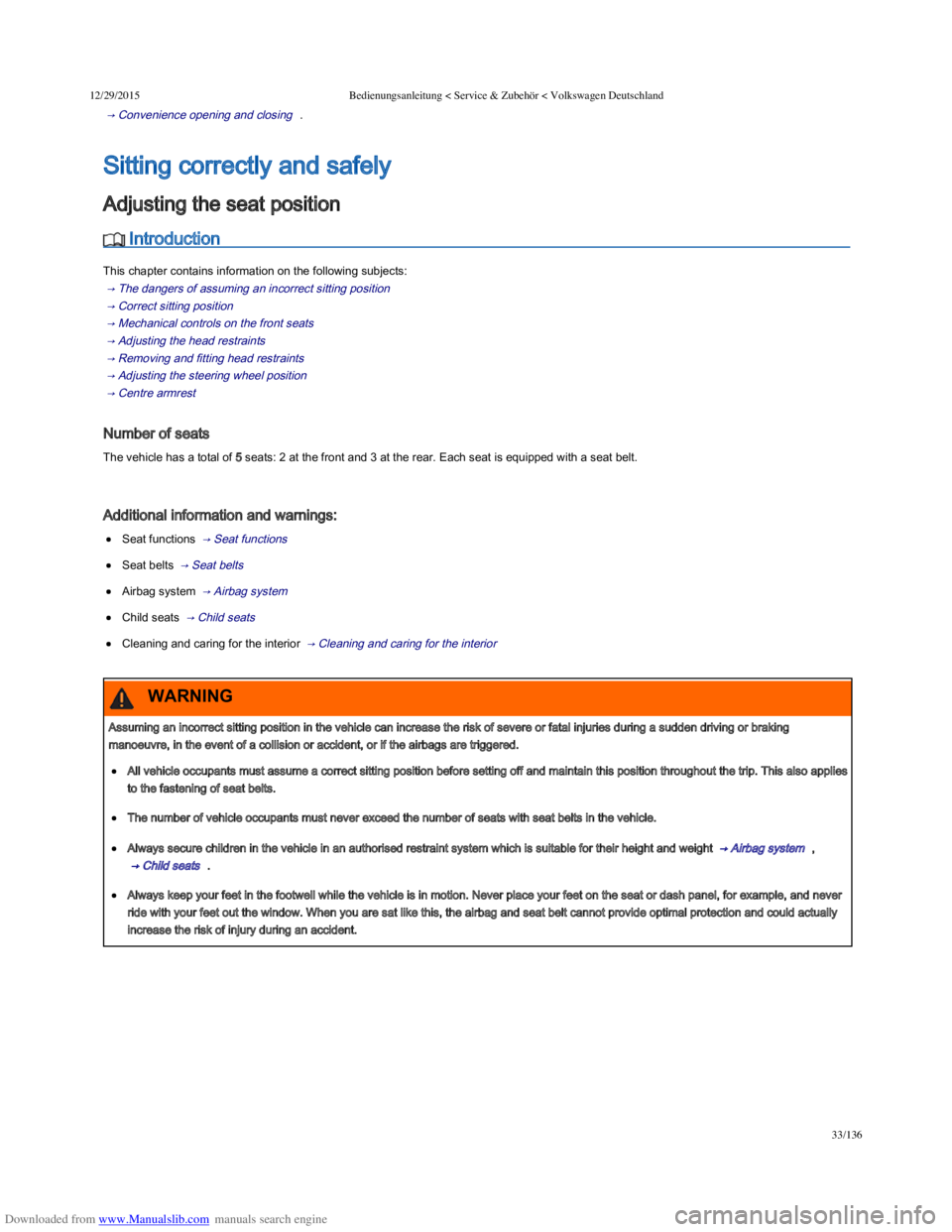
Downloaded from www.Manualslib.com manuals search engine 12/29/2015Bedienungsanleitung < Service & Zubehör < Volkswagen Deutschland
33/136
→ Convenience opening and closing .
Introduction
This chapter contains information on the following subjects:
→ The dangers of assuming an incorrect sitting position
→ Correct sitting position
→ Mechanical controls on the front seats
→ Adjusting the head restraints
→ Removing and fitting head restraints
→ Adjusting the steering wheel position
→ Centre armrest
Number of seats
The vehicle has a total of 5 seats: 2 at the front and 3 at the rear. Each seat is equipped with a seat belt.
Additional information and warnings:
Seat functions → Seat functions
Seat belts → Seat belts
Airbag system → Airbag system
Child seats → Child seats
Cleaning and caring for the interior → Cleaning and caring for the interior
Sitting correctly and safely
Adjusting the seat position
Assuming an incorrect sitting position in the vehicle can increase the risk of severe or fatal injuries during a sudden driving or braking
manoeuvre, in the event of a collision or accident, or if the airbags are triggered.
All vehicle occupants must assume a correct sitting position before setting off and maintain this position throughout the trip. This also applies
to the fastening of seat belts.
The number of vehicle occupants must never exceed the number of seats with seat belts in the vehicle.
Always secure children in the vehicle in an authorised restraint system which is suitable for their height and weight → Airbag system ,
→ Child seats .
Always keep your feet in the footwell while the vehicle is in motion. Never place your feet on the seat or dash panel, for example, and never
ride with your feet out the window. When you are sat like this, the airbag and seat belt cannot provide optimal protection and could actually
increase the risk of injury during an accident.
WARNING
Page 73 of 100
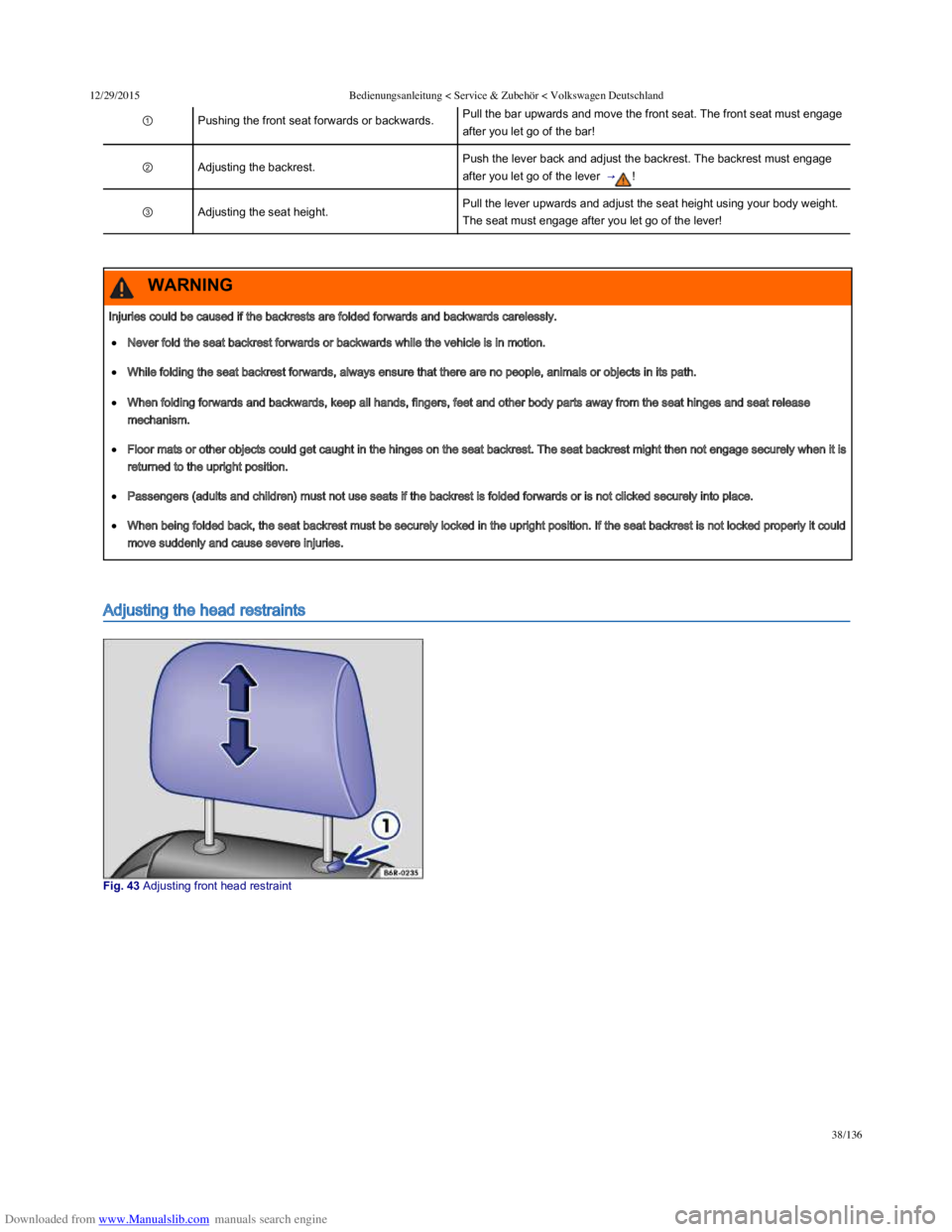
Downloaded from www.Manualslib.com manuals search engine 12/29/2015Bedienungsanleitung < Service & Zubehör < Volkswagen Deutschland
38/136
①Pushing the front seat forwards or backwards.Pull the bar upwards and move the front seat. The front seat must engage
after you let go of the bar!
②Adjusting the backrest.Push the lever back and adjust the backrest. The backrest must engage
after you let go of the lever → !
③Adjusting the seat height.Pull the lever upwards and adjust the seat height using your body weight.
The seat must engage after you let go of the lever!
Adjusting the head restraints
Fig. 43 Adjusting front head restraint
Injuries could be caused if the backrests are folded forwards and backwards carelessly.
Never fold the seat backrest forwards or backwards while the vehicle is in motion.
While folding the seat backrest forwards, always ensure that there are no people, animals or objects in its path.
When folding forwards and backwards, keep all hands, fingers, feet and other body parts away from the seat hinges and seat release
mechanism.
Floor mats or other objects could get caught in the hinges on the seat backrest. The seat backrest might then not engage securely when it is
returned to the upright position.
Passengers (adults and children) must not use seats if the backrest is folded forwards or is not clicked securely into place.
When being folded back, the seat backrest must be securely locked in the upright position. If the seat backrest is not locked properly it could
move suddenly and cause severe injuries.
WARNING
Page 74 of 100
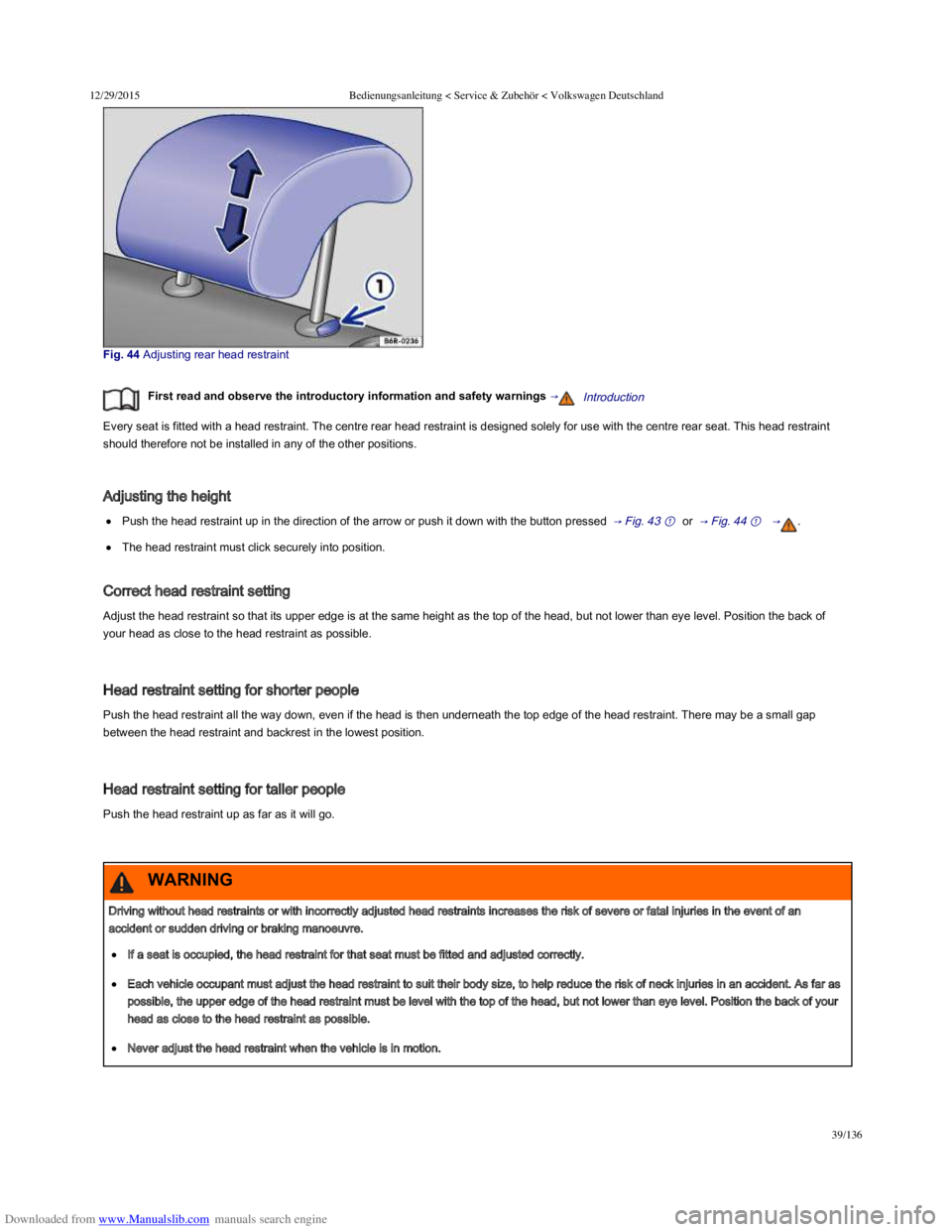
Downloaded from www.Manualslib.com manuals search engine 12/29/2015Bedienungsanleitung < Service & Zubehör < Volkswagen Deutschland
39/136
Fig. 44 Adjusting rear head restraint
First read and observe the introductory information and safety warnings →Introduction
Every seat is fitted with a head restraint. The centre rear head restraint is designed solely for use with the centre rear seat. This head restraint
should therefore not be installed in any of the other positions.
Adjusting the height
Push the head restraint up in the direction of the arrow or push it down with the button pressed → Fig. 43 ① or → Fig. 44 ① → .
The head restraint must click securely into position.
Correct head restraint setting
Adjust the head restraint so that its upper edge is at the same height as the top of the head, but not lower than eye level. Position the back of
your head as close to the head restraint as possible.
Head restraint setting for shorter people
Push the head restraint all the way down, even if the head is then underneath the top edge of the head restraint. There may be a small gap
between the head restraint and backrest in the lowest position.
Head restraint setting for taller people
Push the head restraint up as far as it will go.
Removing and fitting head restraints
Driving without head restraints or with incorrectly adjusted head restraints increases the risk of severe or fatal injuries in the event of an
accident or sudden driving or braking manoeuvre.
If a seat is occupied, the head restraint for that seat must be fitted and adjusted correctly.
Each vehicle occupant must adjust the head restraint to suit their body size, to help reduce the risk of neck injuries in an accident. As far as
possible, the upper edge of the head restraint must be level with the top of the head, but not lower than eye level. Position the back of your
head as close to the head restraint as possible.
Never adjust the head restraint when the vehicle is in motion.
WARNING
Page 75 of 100
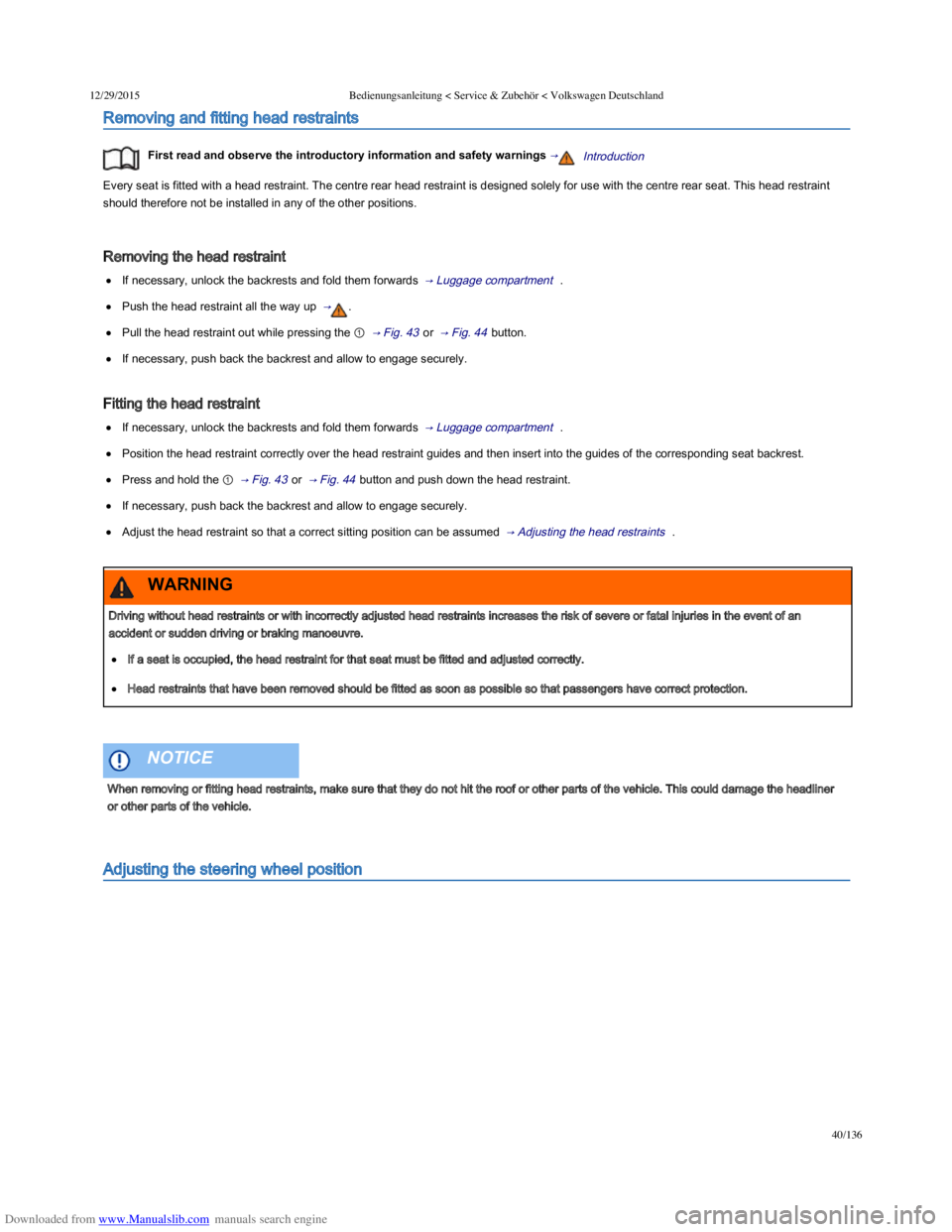
Downloaded from www.Manualslib.com manuals search engine 12/29/2015Bedienungsanleitung < Service & Zubehör < Volkswagen Deutschland
40/136
Removing and fitting head restraints
First read and observe the introductory information and safety warnings →Introduction
Every seat is fitted with a head restraint. The centre rear head restraint is designed solely for use with the centre rear seat. This head restraint
should therefore not be installed in any of the other positions.
Removing the head restraint
If necessary, unlock the backrests and fold them forwards → Luggage compartment .
Push the head restraint all the way up → .
Pull the head restraint out while pressing the ① → Fig. 43 or → Fig. 44 button.
If necessary, push back the backrest and allow to engage securely.
Fitting the head restraint
If necessary, unlock the backrests and fold them forwards → Luggage compartment .
Position the head restraint correctly over the head restraint guides and then insert into the guides of the corresponding seat backrest.
Press and hold the ① → Fig. 43 or → Fig. 44 button and push down the head restraint.
If necessary, push back the backrest and allow to engage securely.
Adjust the head restraint so that a correct sitting position can be assumed → Adjusting the head restraints .
Adjusting the steering wheel position
Driving without head restraints or with incorrectly adjusted head restraints increases the risk of severe or fatal injuries in the event of an
accident or sudden driving or braking manoeuvre.
If a seat is occupied, the head restraint for that seat must be fitted and adjusted correctly.
Head restraints that have been removed should be fitted as soon as possible so that passengers have correct protection.
WARNING
When removing or fitting head restraints, make sure that they do not hit the roof or other parts of the vehicle. This could damage the headliner
or other parts of the vehicle.
NOTICE
Page 76 of 100
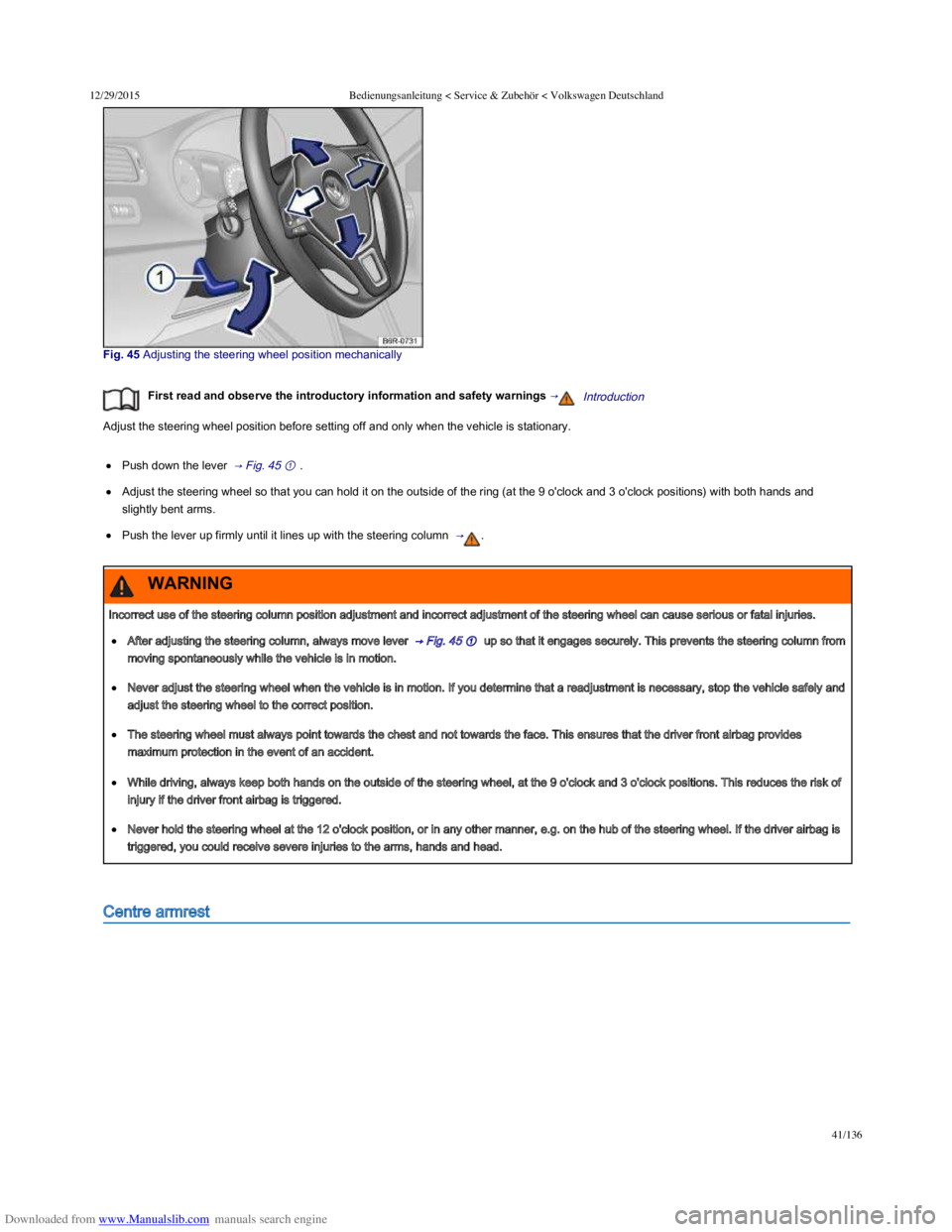
Downloaded from www.Manualslib.com manuals search engine 12/29/2015Bedienungsanleitung < Service & Zubehör < Volkswagen Deutschland
41/136
Fig. 45 Adjusting the steering wheel position mechanically
First read and observe the introductory information and safety warnings →Introduction
Adjust the steering wheel position before setting off and only when the vehicle is stationary.
Push down the lever → Fig. 45 ① .
Adjust the steering wheel so that you can hold it on the outside of the ring (at the 9 o'clock and 3 o'clock positions) with both hands and
slightly bent arms.
Push the lever up firmly until it lines up with the steering column → .
Centre armrest
Incorrect use of the steering column position adjustment and incorrect adjustment of the steering wheel can cause serious or fatal injuries.
After adjusting the steering column, always move lever → Fig. 45 ① up so that it engages securely. This prevents the steering column from
moving spontaneously while the vehicle is in motion.
Never adjust the steering wheel when the vehicle is in motion. If you determine that a readjustment is necessary, stop the vehicle safely and
adjust the steering wheel to the correct position.
The steering wheel must always point towards the chest and not towards the face. This ensures that the driver front airbag provides
maximum protection in the event of an accident.
While driving, always keep both hands on the outside of the steering wheel, at the 9 o'clock and 3 o'clock positions. This reduces the risk of
injury if the driver front airbag is triggered.
Never hold the steering wheel at the 12 o'clock position, or in any other manner, e.g. on the hub of the steering wheel. If the driver airbag is
triggered, you could receive severe injuries to the arms, hands and head.
WARNING